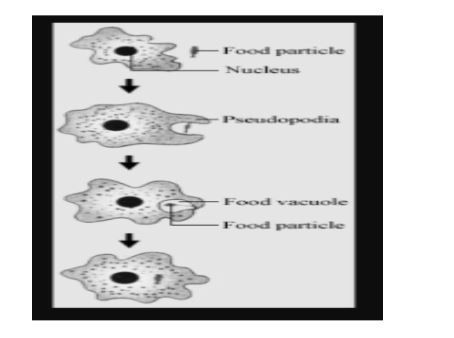Introduction
Amoebas are distinguished from other bacteria by their ability to develop transient cytoplasmic extensions known as pseudopodia, or false feet, which they use to travel throughout the body. Animal locomotion based on this type of movement, which is known as amoeboid movement, is thought to be the most primordial form of animal mobility.
To better understand the respective activities and interconnections of the nucleus and the cytoplasm, amoebas are frequently utilised in cell research. There is a small quantity of jellylike cytoplasm in each amoeba, which can be further separated into three distinct layers: a thin outer plasma membrane; a layer of stiff, transparent ectoplasm just within the plasma membrane; and a center granular endoplasm. Food vacuoles, a granular nucleus, and a distinct contractile vacuole are all seen in the endoplasm of the cell.
The amoeba does not have a mouth or anus; food is taken in and waste ejected from the cell surface at any place along the cell surface. As food particles pass through the digestive tract, extensions of cytoplasm flow around them, encircling them and producing a vacuole into which enzymes are produced to break down the particles. Aeration of the cell by surrounding water allows oxygen to flow into the cell, while metabolic wastes are expelled by the amoeba into the surrounding water. Almost all marine and parasitic species lack a contractile vacuole, which is responsible for the removal of surplus water from the amoeba. Asexual reproduction is the norm (binary fission).
Many amoebas survive by encystment, which is a process in which the amoeba becomes circular, loses most of its water, and secretes a cyst membrane that serves as a protective covering during severe environmental conditions. When the environment becomes suitable once more, the envelope ruptures and the amoeba emerges from the sand.
Mode of Nutrition in Amoeba
Protozoa such as amoeba are prevalent in freshwater and are a form of protozoa. It subsists on the nutrients provided by waterborne microorganisms. In amoebas, the mode of nutrition is known as holozoic nutrition. Phagocytosis is the process through which an amoeba receives food from its environment. A mechanism known as phagocytosis, in which the entire organism consumes the food it intends to consume, permits amoeba to obtain its nutrients from its environment. Holozoic nutrition is the term used to describe the process by which an amoeba consumes nutrients. It is the first step in the process of ingestion, digestion, and egestion of a food product. Amoebae do not have any organs that are specifically designed for nourishment. Using pseudopodia, it is able to complete the entire procedure by passing through the body’s outer surface.
Process of Nutrition in Amoeba

The Holozoic Nourishment process refers to the method by which creatures ingest nutrition from either solid or liquid food and store it in their bodies. The following five steps are involved in the process of consuming nutrition:
- Ingestion
- Digestion
- Absorption
- Assimilation
- Egestion
Ingestion
The procedure of Ingestion refers to the process of ingesting food into the body, which can be accomplished either by swallowing or absorbing it. The amoeba oozes out pseudopodia to envelop and devour the food, resulting in the formation of a feeding vacuole. Phagocytosis is the term used to describe this process.
Digestion
It is known as the Digestion process because it is the process by which insoluble and massive food molecules are broken down into soluble and minute molecules. The digestion of amoebas takes place intracellularly, within the cell. The food is stored in a food vacuole, also known as a stomach vacuole, which is made up of the cell membrane and a small quantity of cytoplasm, and it is located in the stomach.
The movement of the cytoplasm transports the vacuoles deeper into the cells. In this region, they form a complex with lysosomes, which contain enzymes. A number of enzymes have been found, including Amylase and Proteinase. Various substances such as sugars, cellulose, and proteins can be digested by amoebas. Anemones move the food vacuoles further into the cell, where they work with the digestive enzymes to break down the huge insoluble particles into smaller, more easily digestible molecules that can be assimilated.
Absorption
This process of absorption occurs when nutrients from digested food material are absorbed by the cytoplasm of a cell while the undigested particles remain in the cytoplasm of the cell. Diffusion is the term used to describe this phenomenon. Excess food is converted into glycogen and lipids, which are then stored.
Assimilation
The practice of Assimilation is the term used to describe the process of generating energy from the absorbed food molecules. During the life of an amoeba, absorbed food molecules are converted into energy that is used to maintain the various life processes that occur within the cell.
Egestion
Egestion is the term used to describe the process of excreting undigested dietary items. This procedure is carried out in amoebas by rupturing the cell wall, which allows the organism to expel the undigested food items from its body. Exocytosis is the process of ingesting a food product. Undigested materials are moved to the back of the amoeba and discharged as food pellets through a transitory hole that can be created at any location on the plasmalemma as the amoeba progresses ahead in its life cycle (see figure).
Amoebae have a feeding mechanism that is heterotrophic. Given that it is a basic, single-celled organism, the amoeba has the ability to take in food from over its entire surface. The digestion of food happens in food vacuoles rather than in a specialised digestive system, which is a primitive form of digestion.
Conclusion
In its mechanism of nourishment, Amoeba exhibits heterotrophic behaviour. Because amoeba is a basic, single-celled organism, the food can be ingested by the entire surface of the organism. In addition, there is no specialised digestive system, but rather a rudimentary sort of digestion that takes place in food vacuoles (vesicles). It is a holozoic sort of nutrition that amoebae rely on for their sustenance. Amoebae do not have any organs that are specifically designed for nourishment. When an amoeba performs its whole process, a false project of its body surface known as pseudopodia is used to facilitate it. Amoeba feeds by phagocytosis, which is a process in which the entire organism is absorbed and consumed.
 Profile
Profile Settings
Settings Refer your friends
Refer your friends Sign out
Sign out






